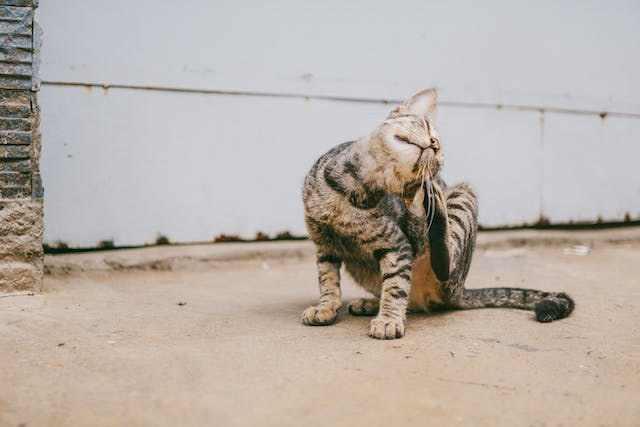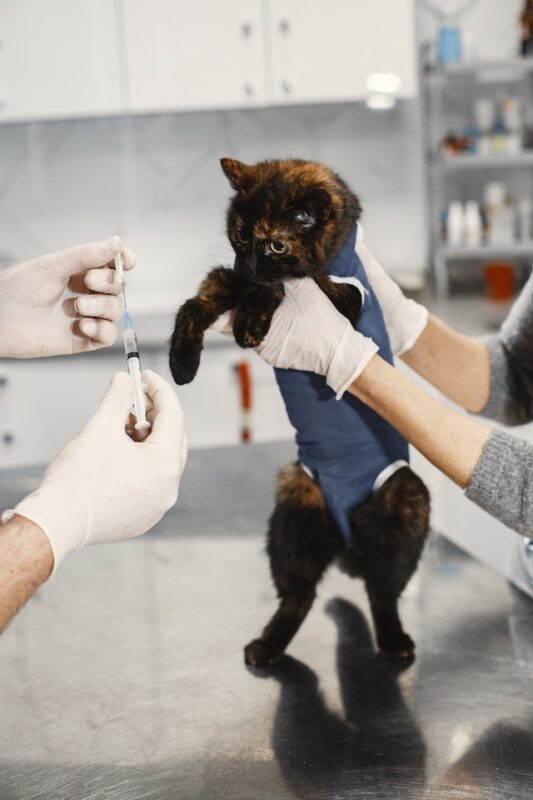Treating Mange in Cats
Posted: 04/02/2024 | BY: Jenna Bruce | Categories: Cat , Ear infection , Health problems
Is your fur baby scratching up a storm? It might be mange. Mange is caused by microscopic mites burrowing into the skin and can be quite bothersome for your feline friend. The good news is that there are effective treatments available, but the specific approach will depend on the type of mite causing the issue. Keep reading to learn about treating mange in cats.

What Is Mange in Cats?
Mange is an umbrella term that refers to an infestation of a parasitic mite. In cats, mange may be caused by a variety of parasites, including:
Ear Mites
Ear mites are common parasites and typically cause a mild parasitic infection in cats. Because these mites are highly contagious, they can usually be found on other parts of your cat’s body besides just their ears.
Walking Dandruff
Called Cheyletiella mites, this is another highly contagious infection that can spread to other animals and humans. These mites feed on skin dander and secretions.
Demodex Mites
These mites can infect a cat’s skin, hair follicles and ear canals. One species of these mites is contagious to other cats but not to dogs.
Scabies Mites
There are two types of mites that causes feline scabies: Notoedres cati (feline scabies) and Sarcoptes scabiei (canine scabies). Though feline scabies is not all that common, both species of these mites are highly contagious.

Chiggers
With these particular parasites, only the larvae feed on the cat, and usually for only a week before they fall off. Chiggers are not contagious from other animals.
Fur Mites
Fur mites are pretty rare and typically only seen in more tropical regions like Hawaii and the Florida Keys. These mites live on the shafts of your cat’s hair, and usually near the rear end. They are not highly contagious between cats.
Symptoms of Mange in Cats
No matter what type of parasite is causing your cat’s mange, they all share some common symptoms of itching and scratching. You will usually also see sores or crusty skin and hair loss in areas.
The following are more specific symptoms you will see with each type of mange:
Ear Mites
- Scratching the ears, head, and neck
- Frequent headshaking
- Dry discharge in the ear canal that is a black or brown color
Should the ear mites spread to other areas of your cat’s body, you may see:
- scaling or crusting of the skin on the neck, rump, and tail
- Generalized itching and scratching
Walking Dandruff
- Excessive skin scaling and dandruff, generally along the back
- Itching
- Overgrooming
- Hair loss
- Crusty sores
- Demodex Mites
- Depending on the species of Demodex mite, you may see:
- Itching/overgrooming
- Hair loss
- Scaly or crusty skin or sores
- Debris/irritation in the ear
- Headshaking
- Redness
Feline Scabies
- Crusty, itchy edges of the ears
- Intense itching
- Flaking skin
- Hair loss
- Inflammation
Chiggers
- Itching
- Redness
- Crusty skin or lesions
- Hair loss
Fur Mites
- Rarely, dull, dry, rust-colored, or salt-and-pepper coat
- Itchiness, also very rare
- Hair loss, especially the rear half of the body
Treatment for Mange in Cats

If you suspect your cat has mange, you will want to get them in to see your vet as soon as possible. If you have a multi-cat household, be sure to quarantine the fur baby who may have mange.
Your vet will perform a physical examination and also some other tests such as a skin scraping, fecal test or tape test. Should your cat be diagnosed with mange, your vet will prescribe a treatment based on the type of mange your cat has.
Ear Mites
Ear mites are fairly simple to treat using some ear drops such as Acarexx®, MilbeMite®, or Otomite Plus®.
Walking Dandruff
At this time there is no product that has been licensed to specifically treat walking dandruff in cats. Usually vets prescribe a flea and tick medication to treat walking dandruff. All other pets in the house must also be treated with flea and tick medication to stop that infection in its tracks!
Demodex
The same treatment is typically used for all species of Demodex mites, which is weekly 2% lime sulfur dips. You will need to do this for several weeks. Some vets may also decide to treat using Bravecto® or Revolution Plus®. Treat all other exposed cats as well.
Feline Scabies
The usual treatment for feline scabies is ivermectin injections. There are also some flea medications that are not approved to treat scabies in cats (because the condition is so rare) but are often used because they are so effective. These are:
- Bravecto®
- Revolution Plus®
- Revolution®
- Advantage Multi®
Chiggers
While flea and tick medications are not specifically approved to treat chiggers, they are often used because they work so well getting rid of them.

Fur Mites
This is another condition that can be successfully treated using common flea and tick products. Be sure to treat any other pets in your home as well.
Final Thoughts
As you can see, treating mange in cats is fairly simple. The most important part is not trying to treat your cat’s mange by yourself. Your vet will need to diagnose which type of parasite is causing the itching and prescribe the right treatment for it.
Vet Bills – Not Itchy, But Often Uncomfortable
Luckily treating mange in cats is quite affordable. But there are those times when our fur baby is suddenly struck with a serious injury or illness that requires thousands of dollars in medical care. Are you able to pay a high vet bill?
Most pet parents do not have any significant savings and many go into debt to help get their fur baby the help they need. This is why more and more pet parents are enrolling their pets into a pet insurance plan that can reimburse them for up to 90% of the vet bills.
If you’ve been thinking about pet insurance but weren’t sure which company was best, here are the top pet insurance providers – in order – based on over 150,000 authentic reviews from pet parents just like you:
Top Pet Insurance Providers of 2025
| Rating | Provider | Total Review |
|---|---|---|
| 4.9 | Embrace | 18,417 |
| 4.9 | Healthy Paws | 10,193 |
| 4.9 | Trupanion | 60,916 |
| 4.9 | Fetch | 26,334 |
| 4.9 | Lemonade | 809 |
| 4.8 | Nationwide | 21,411 |
| 4.8 | Prudent Pet | 1,789 |
| 4.7 | Pumpkin | 1,686 |
| 4.6 | Hartville | 170 |
| 4.6 | ManyPets | 2,381 |
| 4.6 | Spot | 8,026 |
| 4.5 | ASPCA | 11,876 |
| 4.5 | PetPartners | 115 |
| 4.4 | AKC | 893 |
| 4.3 | Pets Best | 12,925 |
| 4.2 | Figo | 2,617 |
| 4.0 | Pet Assure | 13 |
| 3.9 | MetLife | 736 |
References:
- https://www.webmd.com/pets/cats/cat-mange-scabies
- https://www.merckvetmanual.com/cat-owners/skin-disorders-of-cats/mite-infestation-mange,-acariasis,-scabies-of-cats
Disclaimer
The information contained on this blog is intended for informational and educational purposes only and should not be construed as medical advice. It is not a substitute for professional veterinary care. Always consult with your veterinarian before making any changes to your pet's health care or treatment plan.
The authors of this blog are not veterinarians and do not claim to be experts in pet health. The information provided here is based on our own experiences and research, as well as information from reputable sources. However, we cannot guarantee the accuracy or completeness of this information.
We encourage you to do your own research and consult with your veterinarian before making any decisions about your pet's health.
Previous post
What Flowers are Safe for Cats?Next post
How Do Cats Get Worms?Compare top pet insurance providers & plans.
Enter your dog’s age in years and months to calculate their age equivalent to human years.
Calculate your dog’s ageEnter your cat’s age in years and months to calculate their age equivalent to human years.
Calculate your cat’s age
